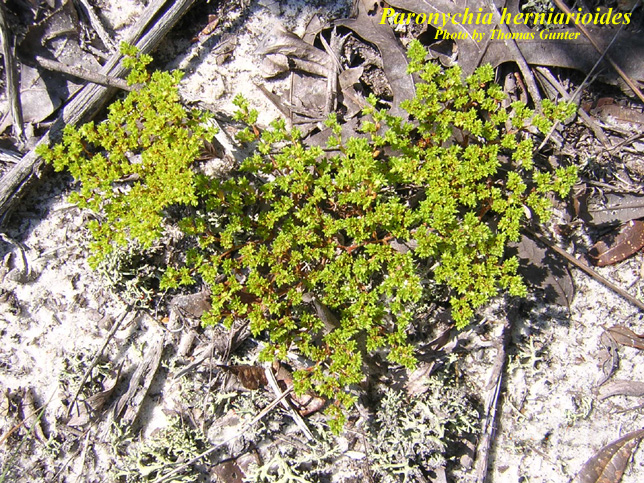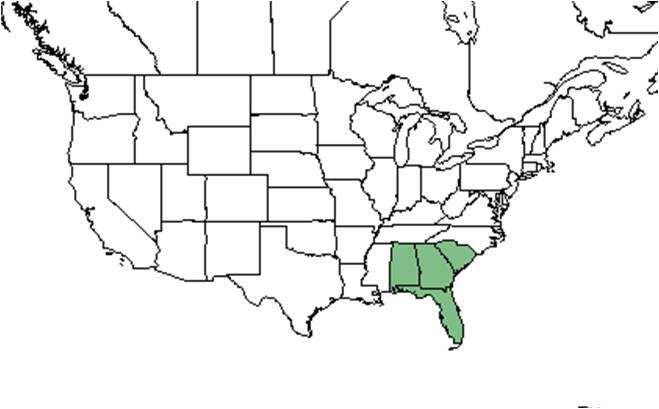Difference between revisions of "Paronychia herniarioides"
Emmazeitler (talk | contribs) |
|||
| Line 55: | Line 55: | ||
<!--===Diseases and parasites===--> | <!--===Diseases and parasites===--> | ||
| − | ==Conservation and | + | ==Conservation, cultivation, and restoration== |
| − | == | + | ==Cultural use== |
==Photo Gallery== | ==Photo Gallery== | ||
<gallery widths=180px> | <gallery widths=180px> | ||
Revision as of 17:58, 8 June 2021
| Paronychia herniarioides | |
|---|---|

| |
| Photo by Thomas Gunter, Atlas of Florida Vascular Plants | |
| Scientific classification | |
| Kingdom: | Plantae |
| Division: | Magnoliophyta - Flowering plants |
| Class: | Magnoliopsida – Dicotyledons |
| Order: | Caryophyllales |
| Family: | Caryophyllaceae |
| Genus: | Paronychia |
| Species: | P. herniarioides |
| Binomial name | |
| Paronychia herniarioides (Michx.) Nutt. | |

| |
| Natural range of Paronychia herniarioides from USDA NRCS Plants Database. | |
Common names: Coastal plain nailwort; Michaux's whitlow-wort[1]
Contents
Taxonomic notes
Synonyms: Gastronychia herniarioides (Michx.) Small.[1]
Varieties: none.[1]
Paronychia comes from a Greek word for whitlow, a disease that infected the fingers.[2]
Description
A description of Paronychia herniarioides is provided in The Flora of North America.
This species is a prostrate, pubescent annual. It is diffusely branched with limbs that are 0.5-3.5 dm long. The leaves are obtuse, 3-12 mm long, and 1.5-3.5 mm wide, with an oblong-elliptic or spatulate shape. The stipules 0.5-4 mm long and the calyx is turgidly basal. The sepals are brown, indurate, pubescent, short-awned.[1][3]
Distribution
The distribution of P. herniarioides is restricted to the southeastern Coastal Plain from South Carolina south to Florida and west to Alabama. It is rare in South Carolina and Florida.[4]
Ecology
Habitat
In the Coastal Plain, P. herniarioides occurs in xeric, sandy soil of longleaf pine-turkey oak sand ridges. Associated species include Lyonia ferruginea, Ceratiola, Stylisma pickeringii var. pickeringii, Opuntia humifusa, Quercus geminata, Quercus myrtifolia and Polygonella.[5][6]
Phenology
This species flowers from April through June.[3]
Pollination
The following Hymenoptera families and species were observed visiting flowers of Paronychia herniarioides at Archbold Biological Station:[7]
Halictidae: Lasioglossum nymphalis
Sphecidae: Tachysphex apicalis
Conservation, cultivation, and restoration
Cultural use
Photo Gallery
References and notes
- ↑ 1.0 1.1 1.2 1.3 Weakley, A.S. 2015. Flora of the southern and mid-atlantic states. Working Draft of 21 May 2015. University of North Carolina at Chapel Hill, Chapel Hill, North Carolina.
- ↑ Core, E. L. (1941). "The North American Species of Paronychia." The American Midland Naturalist 26(2): 369-397
- ↑ 3.0 3.1 Radford, A. E., Ahles, H. E., & Bell, C. R. (1968). Manual of the vascular flora of the Carolinas. Chapel Hill: University of North Carolina Press.
- ↑ [[1]] NatureServe Accessed: February 19, 2016
- ↑ Florida State University Robert K. Godfrey Herbarium database. URL: http://herbarium.bio.fsu.edu. Last accessed: October 2015. Collectors: Oscar E. Baynard, Morton Bortell, L.J. Brass, R.A. Davidson, Robert K. Godfrey, D.W. Hall, R. Kral, A.M. Laessle, N.E. Lee, R.A. Norris, Kent D. Perkins, A.E. Radford, Grady W. Reinert, G.L. Webster, R.L. Wilbur, R.F. Thorne. States and Counties: Florida: Clay, Gilchrist, Highlands, Lake. Georgia: Ben Hill, Coffee, Dougherty, Emanuel, Marion, Mitchell, Wheeler. South Carolina: Lee. Compiled by Tall Timbers Research Station and Land Conservancy.
- ↑ Schotz, A. (2009). "Noteworthy Collection: Alabama." Castanea 74(2): 185-188.
- ↑ Deyrup, M.A. and N.D. 2015. Database of observations of Hymenoptera visitations to flowers of plants on Archbold Biological Station, Florida, USA.